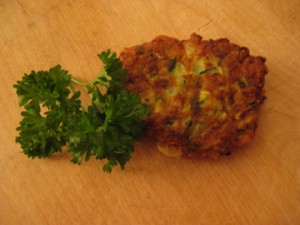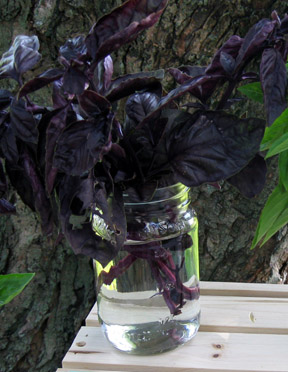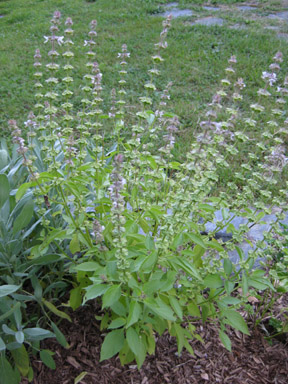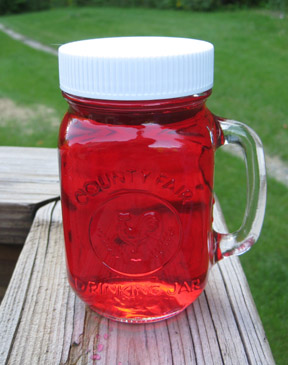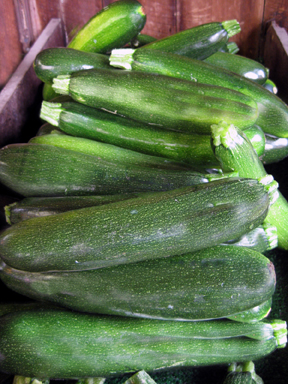
How do I love zucchini? Let me count the ways….
I know zucchini don’t always come in for a lot of praise. In fact, I tend to think of them as the fruitcake of summer.
At Christmas the fruitcake bashers jest that fruitcake is so heavy it can be used as a doorstop. In early September the jokesters snicker that country dwellers are so frustrated with their bumper crops of zucchini that as soon as the sun sets they tiptoe around and leave the things on their neighbors’ doorsteps.
It’s true that even one little zucchini vine can go crazy if left untended. Gardeners who forget to check their patch for a couple of days end up with vegetables the size of baseball bats instead of the tender little green gourds that inspired the Italian name “zucchini,” which means ”little squash.”
(Actually, in Italian the word would be “zucchine.” I hate to be overly pedantic, but I was an editor for years so I’m prone to linguistic nitpicking.)
If you remember to check your zucchini patch frequently, however, you’ll be rewarded with small, curvy cylinders that are highly versatile.
They cook quickly, especially if you just fry slices in a little butter and olive oil and toss in a few herbs and a little salt and pepper.
Grated zucchini can lend vitamin A and moisture to soups, sauces, breads, brownies, cakes, and casseroles.
You may also use zucchini to make pickles or relish and stretch summer’s bounty throughout the year.
Zucchini are cheap, and they’re good for you. As my grandmother used to say, “What’s not to like?”
So–if any of my neighbors would like to leave a few zucchini on my doorstep, I say, “Bring ‘em on!” I didn’t grow any myself this year, and I have several zucchini recipes to share with readers. Here is the first.
I learned to make these zucchini pancakes last year when I was working as a demo chef at Bloomingdale’s in Tysons Corner, Virginia. Pat Money, the Calphalon cookware representative, suggested that they would show off her pans nicely. They certainly did! I have changed the recipe a little from Pat’s version (a characteristic failing of mine), but I’ve kept the essence of the pancakes intact.
As you can see, they’re on the fattening side–so make them when you have a crowd coming over. They’ll disappear.
Zucchini Pancakes
Ingredients:
2 large eggs, lightly beaten
1 tablespoon canola oil
1 small onion, finely minced
1 clove garlic, finely minced
1 cup freshly grated Parmesan cheese (add a little more if you like)
1-1/2 teaspoons baking powder
1/2 teaspoon salt
lots of freshly ground pepper
2 medium zucchini, grated and squeezed dry in a dish towel (about 4 cups)
1 cup flour
extra-virgin olive oil as needed for frying
1 tablespoon canola oil
1 small onion, finely minced
1 clove garlic, finely minced
1 cup freshly grated Parmesan cheese (add a little more if you like)
1-1/2 teaspoons baking powder
1/2 teaspoon salt
lots of freshly ground pepper
2 medium zucchini, grated and squeezed dry in a dish towel (about 4 cups)
1 cup flour
extra-virgin olive oil as needed for frying
Instructions:
In a bowl, combine the eggs, canola oil, onion, garlic, cheese, baking powder, salt, and pepper.
Stir in the zucchini, followed by the flour.
Pour enough olive oil into the bottom of a nonstick frying pan to coat the bottom of the pan. Heat the oil over medium to medium-high heat until it shimmers.
Place heaping soup spoons full of the zucchini batter into the pan, about 4 to 5 at a time. Flatten them slightly and fry them until they are golden around the edges and can be turned, about 3 minutes. Turn them over and fry them until they are golden on the other side, 2 to 3 minutes longer. If you need to add a bit more oil during this process, do so.
Drain the pancakes on paper towels and serve them warm. Makes 25 to 30 small pancakes.
